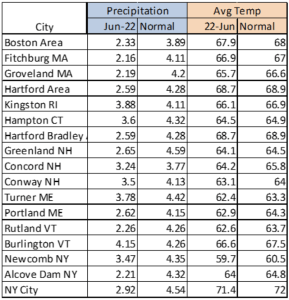 Drought Conditions
Drought Conditions
We are entering the hottest weeks of the summer. With the exception of northern Maine, all areas of New England are experiencing Abnormally Dry to Severe Drought conditions. Weather.gov’s chart below shows many areas experiencing ½” to over 2” less precipitation for the month of June. Thankfully, temperatures for the month of June were very close to average. This helped mitigate some of the stressors from lack of rain.
U.S. Drought Monitor Source

Dormancy
Due to a lack of moisture, grass is brown and dormant on non-irrigated lawns that are exposed to full sun. In addition, watering restrictions are also increasing by towns and cities. Therefore increasing the importance of water conservation management practices. If grass has begun to go dormant, you can allow it to continue into dormancy for the remainder of the summer. Increasing watering right now in an effort to reverse the process can have adverse effects. These effects include the unintended impact of increasing germination of undesirable weeds (in particular crabgrass).
Recovery
As we come out of summer—towards the end of August and beginning of September—the focus should be on lawn recovery. The nights begin to cool and dew forms on the grass blades. This creates more favorable growing conditions. We recommend aerating to relieve compaction from summer heat and foot traffic. In addition, over-seeding will thicken the turf. Applying PJC ProHealthy Turf organic fertilizer and Charge-S3 will provide a food source for the biology. Then, as grass comes out of dormancy, soil biology will feed the grass plant and provide the nutrition it needs to recover.
Going Forward
Preparing lawns for the summer drought stressors ideally should begin well before the heat ever arrives.
- EFFECTIVE WATERING — deep, infrequently and in the morning. ¾” – 1” of water per week (natural or supplemental).
- ALLOW SOIL TO DRY — Soil should be allowed to dry out between watering to allow for proper soil moisture depletion. This promotes higher soil-water storage capacity to utilize precipitation. Soil drying also decreases soil compaction tendencies, promotes greater rooting depth with less water, and increases stress tolerance.
- SHADE — Maintaining good turf grass cover and soil shading will help reduce evaporative water loss. Grass should be mowed high at 3 ½”to improve soil shading, deeper root structure, as well as reduce stress. Planting trees in very sunny areas is a great way to increase soil shading as well.
- SOIL HEALTH — Building soil health by increasing soil organic matter makes a big difference! Every 1% increase in soil organic matter helps soil hold 20,000 more gallons of water per acre. What you do in the spring and fall plays a part in how your lawn will recover – and most lawns will bounce back!








